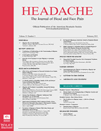 Dr. Todd Smitherman and a number of graduate students have just had two papers accepted for publication in the journal Headache. The citation and abstract for each paper are given below. Congratulations to Dr. Smitherman, Michael McDermott, Kelly Peck, Brooke Walters, Elizabeth Kolivas and Jenn Bailey for their efforts in getting these published.
Dr. Todd Smitherman and a number of graduate students have just had two papers accepted for publication in the journal Headache. The citation and abstract for each paper are given below. Congratulations to Dr. Smitherman, Michael McDermott, Kelly Peck, Brooke Walters, Elizabeth Kolivas and Jenn Bailey for their efforts in getting these published.
“Do Episodic Migraineurs Selectively Attend to Headache-Related Visual Stimuli?” Headache
McDermott, M. J., Peck, K. R., Walters, A. B., & Smitherman, T. A.
Objective.—
To assess pain-related attentional biases among individuals with episodic migraine.
Background.—
Prior studies have examined whether chronic pain patients selectively attend to pain-related stimuli in the environment, but these studies have produced largely mixed findings and focused primarily on patients with chronic musculoskeletal pain. Limited research has implicated attentional biases among chronic headache patients, but no studies have been conducted among episodic migraineurs, who comprise the overwhelming majority of the migraine population.
Methods.—
This was a case-control, experimental study. Three hundred and eight participants (mean age = 19.2 years [standard deviation = 3.3]; 69.5% female; 36.4% minority), consisting of 84 episodic migraineurs, diagnosed in accordance with International Classification of Headache Disorders (2nd edition) criteria using a structured diagnostic interview, and 224 non-migraine controls completed a computerized dot probe task to assess attentional bias toward headache-related pictorial stimuli. The task consisted of 192 trials and utilized 2 emotional-neutral stimulus pairing conditions (headache-neutral and happy-neutral).
Results.—
No within-group differences for reaction time latencies to headache vs happy conditions were found among those with episodic migraine or among the non-migraine controls. Migraine status was unrelated to attentional bias indices for both headache (F [1,306] = 0.56, P = .45) and happy facial stimuli (F [1,306] = 0.37, P = .54), indicating a lack of between-group differences. Lack of within- and between-group differences was confirmed with repeated measures analysis of variance.
Conclusions.—
In light of the large sample size and prior pilot testing of presented images, results suggest that episodic migraineurs do not differentially attend to headache-related facial stimuli. Given modest evidence of attentional biases among chronic headache samples, these findings suggest potential differences in attentional processing between chronic and episodic headache subforms.
http://onlinelibrary.wiley.com/doi/10.1111/head.12011/abstract
“Panic Disorder and Migraine: Comorbidity, Mechanisms, and Clinical Implications.” Headache
Smitherman, T. A., Kolivas, E. D., & Bailey, J. R.
A growing body of literature suggests that comorbid anxiety disorders are more common and more prognostically relevant among migraine sufferers than comorbid depression. Panic disorder (PD) appears to be more strongly associated with migraine than most other anxiety disorders. PD and migraine are both chronic diseases with episodic manifestations, involving significant functional impairment and shared symptoms during attacks, interictal anxiety concerning future attacks, and an absence of identifiable secondary pathology. A meta-analysis of high-quality epidemiologic study data from 1990 to 2012 indicates that the odds of PD are 3.76 times greater among individuals with migraine than those without. This association remains significant even after controlling for demographic variables and comorbid depression. Other less-rigorous community and clinical studies confirm these findings. The highest rates of PD are found among migraine with aura patients and those presenting to specialty clinics. Presence of PD is associated with greater negative impact of migraine, including more frequent attacks, increased disability, and risk for chronification and medication overuse. The mechanisms underlying this common comorbidity are poorly understood, but both pathophysiological (eg, serotonergic dysfunction, hormonal influences, dysregulation of the hypothalamic–pituitary–adrenal axis) and psychological (eg, interoceptive conditioning, fear of pain, anxiety sensitivity, avoidance behavior) factors are implicated. Means of assessing comorbid PD among treatment-seeking migraineurs are reviewed, including verbal screening for core PD symptoms, ruling out medical conditions with panic-like features, and administering validated self-report measures. Finally, evidence-based strategies for both pharmacologic and behavioral management are outlined. The first-line migraine prophylactics are not indicated for PD, and the selective serotonin re-uptake inhibitors used to treat PD are not efficacious for migraine; thus, separate agents are often required to address each condition. Core components of behavioral treatments for PD are reviewed, and their integration into clinical headache practice is discussed.
http://onlinelibrary.wiley.com/doi/10.1111/head.12004/abstract

